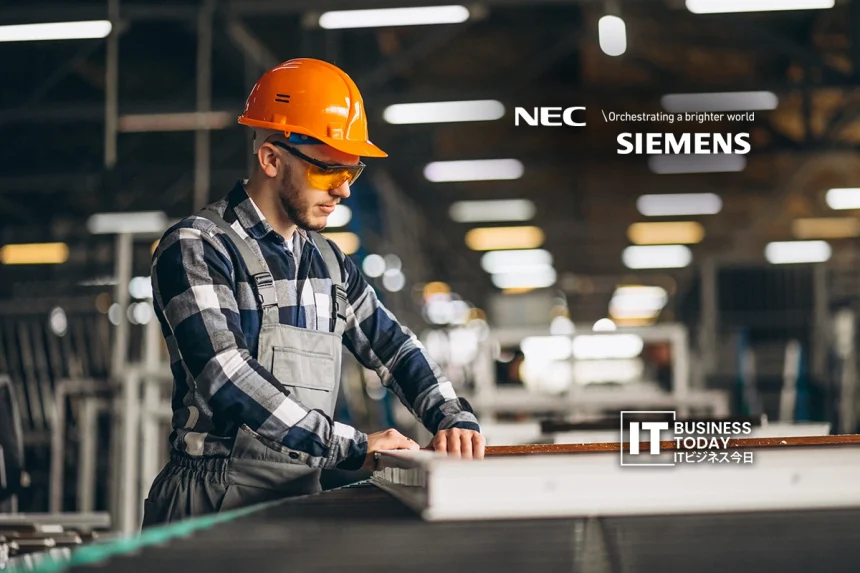NEC Corporation, based in Tokyo, has teamed up with Siemens Industry Software Inc. They signed a Technology Partner Program Agreement. This partnership aims to create and launch advanced 3D robot simulation solutions globally.
The collaboration brings together the “NEC Robot Task Planning” digital twin service under the BluStellar value-creation model from NEC with the widely used “Process Simulate” software from Siemens’ Tecnomatix® portfolio.
NEC will integrate its AI-driven Robot Task Planning solution into Siemens’ Process Simulate environment, which will allow the creation of robot motion plans within the user interface of the 3D simulator.
Also Read: Hitachi High-Tech Presents SU9600 Next-Gen Microscope
The integrated toolset reduces reliance on the traditional, expert engineer-dependent process of manually teaching robots and aims to reduce production-line setup time, optimize cycle time, and facilitate transfer of know-how across sites.
The agreement includes joint marketing activities-seminars and exhibitions-leveraging the sales channels of both companies, with an objective to achieve global scale deployment of the combined solution.
Why this matters for Japan’s tech industry
This move by NEC is significant for Japan’s manufacturing and technology sector on several counts:
Acceleration of digital twin and robotics-enabled automation
Integrating simulation software with robotics motion-planning tools shows a change. It moves us from hardware-only automation to software-driven, data-enabled manufacturing. Japanese manufacturers are known for their precision equipment. Now, they must add digital twin, AI, and simulation capabilities to their systems. With NEC leading through BluStellar, Japan strengthens its capabilities in next-generation manufacturing.
Elevating value in robot automation beyond teaching
This solution directly targets the bottleneck that has often slowed robot deployment in production lines: the cost and time required for the manual teaching of individual robots, particularly when multiple robots must coordinate. By reducing this teaching burden, Japanese manufacturers can move more rapidly toward flexible, reconfigurable production-an imperative in the era of mass customization and supply-chain volatility.
Boosting the software-ecosystem around manufacturing
Japanese tech firms have a strong history in hardware. They excel in areas like robots, precision machinery, and electronics. This announcement highlights the rising importance of software, platforms, and services. These include simulation, AI, and digital twins. NEC’s role shows that domestic tech industries are moving toward software-driven products. This shift creates strategic chances for system integrators, software vendors, and asset owners.
Global competitiveness and export potential
This partnership, clearly targeted at world deployment, extends the reach for Japan-based platforms. A Japanese firm operating in global manufacturing may find that a solution that marries NEC’s local insight and Siemens’ global footprint will leverage export opportunities and help capture global market share in robotics software, positioning Japan as a go-to region for advanced manufacturing solutions.
Effects on businesses operating in this industry
The partnership will affect various business categories in Japan and elsewhere:
Manufacturers and factories: Companies that want to introduce or upgrade robot-enabled production lines will benefit from shorter setup times and fewer engineering bottlenecks. This will enable companies to move away from long robot teaching phases toward more agile project roll-outs.
Robot integrators and automation service providers: The companies will have a combined platform that they can provide to customers. The value proposition is: “Faster deployment, fewer skilled teaching hours” just strengthens their service offering.
Software vendors and digital-twin specialists: With an increased emphasis on simulation, modelling, AI planning, and optimization, software players both in Japan and globally will feel a rise in demand. And NEC’s move signals that simulation software is now central to automation, not peripheral.
SMEs and supply-chain firms: With the availability of improved tools, smaller manufacturing firms who had hitherto decided that robot automation was too costly or complex may be finding the barrier lower. This opens newer markets and service segments.
Challenges and things to watch out for
With the opportunity, however, come the caveats:
Change management and skills: Even with faster-simulation, teaching tools, and with factories having to adapt processes, train personnel, and integrate workflows, the human factor remains important.
Integration across legacy systems: Most Japanese manufacturing sites have long-established equipment and workflows; integrating new simulation-based robot planning tools may require retrofitting, system upgrades, and investment.
Competition and pace: The global platform competition-a very competitive landscape from other robot simulation vendors, Chinese automation providers-needs to be countered by Japan’s speed and innovation.
Operational proof-points: Real-world deployment and case studies will be important. Businesses will want measurable ROI-reduced set-up time, fewer errors-before major roll-outs.
Conclusion
The fact that NEC has entered into a strategic partnership with Siemens Industry Software to advance 3D robot simulation and AI-driven robot task-planning marks a meaningful step for Japan’s technology-manufacturing industry. It is, however, a move away from simply hardware-centric automation toward software, digital twin, and agile production models. For businesses operating in robotics, automation, simulation software, and manufacturing services, it presents both opportunity and challenge: those who move well with the shift to digital twin and smarter automation will likely gain the competitive edge. Japan, through the leadership of NEC, positions itself at the nexus of advanced-manufacturing transformation globally-and the ripple-effects will be felt across industry, supply-chain, and global markets.







